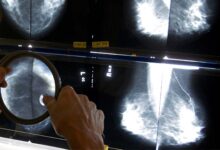What we know about the 8 men killed by Bruce McArthur
Now that Bruce McArthur, 67, has pleaded guilty to eight counts of first-degree murder, we are learning more about the serial killer’s victims at his sentencing hearing.
Some of the victims’ friends and family read victim impact statements on Monday, with others set for Tuesday morning.
Here’s a brief look at what we know about Skandaraj Navaratnam, Abdulbasir Faizi, Majeed Kayhan, Soroush Mahmudi, Kirushna Kumar Kanagaratnam, Dean Lisowick, Selim Esen and Andrew Kinsman.
Skandaraj Navaratnam, 40

(John Fraser/CBC)
Skandaraj Navaratnam, or “Skanda” as he was known to his friends, is remembered as a charming, kind and charismatic man, who came to Canada as a gay immigrant from Sri Lanka.
Long-time friend Kevin Nash first met Navaratnam in 1994, when he was in a relationship with one of Nash’s friends.
“If you knew Skanda, you would love him. He was a very attractive, handsome young man with a charismatic attitude [who] loved to laugh,” said Nash.
One summer Nash’s son briefly went missing, and Nash says Navaratnam hopped on his bicycle and scoured nearby parks looking for him.
Navaratnam met McArthur in 1999, and the two were in a relationship at some point in the early 2000s.
Navaratnam went missing over Labour Day weekend in 2010. He was last seen leaving Zipperz nightclub, near Church and Carlton streets, with an unknown man.
His best friend Jean-Guy Cloutier used to text with him every morning, so when he didn’t hear from Navaratnam for several days he reported him missing.
McArthur killed Navaratnam on or about the day he was last seen.
“Skanda will never be replaceable to me,” said friend Phil Werren, reading a victim impact statement Monday. “This loss has been enormous for his friends and family.”
Navaratnam was “almost unbeatable at Scrabble,” said Werren, who said they saw each other almost every day for a decade.
Abdulbasir Faizi, 44

(John Fraser/CBC)
Abdulbasir Faizi was funny, smart and loved his kids, according to a long-time friend. He was also living a double life as a gay man when he went missing in 2010.
Faizi’s wife, two daughters, and longtime friend had no idea he was frequenting Toronto’s Gay Village neighbourhood until after he disappeared. On Dec. 29, 2010, Faizi called his wife to tell her he was at work with colleagues and would be home later that night.
That was the last time she spoke with him. When Faizi never returned home, his cousin reported him missing to Peel Regional Police the next day. A week later police discovered Faizi’s abandoned car a short drive from the home on Mallory Crescent where the remains of McArthur’s victims were recovered.
In divorce papers Faizi’s wife later filed, she said investigators believed Faizi had abandoned his family and did not want to be found.
But that doesn’t ring true for his friend, who says the last time he spoke to Faizi “he was working overtime to make sure his kids get all the things that were on their wish list for Christmas.”
Police have said McArthur and Faizi knew each other. McArthur killed Faizi on or about the day he went missing.
Majeed Kayhan, 58

(John Fraser/CBC)
Majeed Kayhan lived on Church Street in Toronto’s Gay Village and frequented bars in the area. Kayhan knew McArthur before he went missing.
Karen Fraser, the owner of the Mallory Crescent home where the remains of victims were found, says McArthur once brought Kayhan to her house.
He was last seen by a friend in the area of Alexander and Yonge streets on Oct. 18, 2012.
Kayhan’s adult son reported him missing a week later. McArthur killed him on or about the day he went missing.
Soroush Mahmudi, 50

(John Fraser/CBC)
Soroush Mahmudi was an easy-going jokester who liked to go camping and play soccer. That’s how Brett Morrison remembers him. The two men were friends for about a decade while they worked together at an automotive parts factory in Barrie, Ont.
He says everyone who met Mahmudi liked him.
Mahmudi came to Canada as a refugee when he was about 20. As far as Morrison knows he didn’t have any family in Canada until he met his wife here.
The former colleague says Mahmudi left the factory in 2008, and worked as a taxi driver in Barrie for a while before moving to Toronto to be closer to his wife’s family. After that the two friends lost touch.
Mahmudi was last seen alive on Aug. 15, 2015, near his apartment building on Markham Road in Scarborough. He was killed on or about the same day by McArthur.
Mahmudi’s son-in-law reported him missing.
Kirushna Kumar Kanagaratnam, 37

(John Fraser/CBC)
Kirushna Kumar Kanagaratnam came to Canada in hopes of a “bright future” in a new country that could help him provide for his family in Sri Lanka.
He arrived in 2010 as one of 492 Sri Lankans fleeing his country’s civil war, and seeking asylum aboard the MV Sun Sea cargo ship.
Eventually, he ended up in Toronto, where he worked odd jobs, like moving furniture, to send money home.
His family described him as the “responsible one,” and the fourth of six siblings. Kanagaratnam lost his youngest brother in 2007, when he was killed during the armed conflict between the Sri Lankan government and Tamil fighters.
In 2013, Kanagaratnam told a friend he’d met on the MV Sun Sea that both his application for refugee status and his subsequent appeal had been rejected. In the next couple of years he phoned his mother every day, but the calls stopped coming in late August 2015, and when she tried to call him his phone wasn’t working.
Kanagaratnam’s family was very worried, but never reported him missing because they thought he was in hiding, scared that Canadian authorities planned to send him back to Sri Lanka.
McArthur killed Kanagaratnam in January 2016.
Dean Lisowick, 47

(John Fraser/CBC)
Dean Lisowick was a “sweet guy” who stuck up for his fellow sex-trade workers in the Gay Village. Those who used to work alongside Lisowick described him as a fixture of the community for decades.
“If he saw someone being harassed, or something like that, he was always the first one to come to the rescue,” said M’shel George, a former sex-trade worker. “He was very street savvy, so it just baffled me that he, of all people, would be a victim.”
Lisowick was a regular user of Toronto’s shelter system. He was last admitted to a shelter in April 2016, the same month McArthur killed him. Unlike most of the serial killer’s other victims, Lisowick was never reported missing.
Mita Hans didn’t know Lisowick by name, but remembers him being eager to help out with the informal food program she ran for the homeless at Allan Gardens.
She last saw Lisowick the month he died. Hans was playing music in the park and Lisowick and a friend joined her for a dance.
On Monday, the Crown read out a statement by Lisowick’s daughter, who said she never knew her father.
“I was told he lived on the streets downtown. Growing up knowing that wasn’t easy,” she wrote. “I have a child and another baby on the way and unfortunately one day they will ask about my father and where he is and I will have to tell [them] how he was taken away from the world.”
Selim Esen, 44

(John Fraser/CBC)
Selim Esen’s brothers remember “his tender and kind humanity” before everything else. He was born in Istanbul and grew up in Ankara, where he worked to help support his family, while earning a university degree.
His older brothers, Omer Esen and Ferhat Cinar, say Esen was unhappy as a gay man living in Turkey and spent several years in Australia before moving to Canada in 2013 to marry his boyfriend. The relationship didn’t last, but Esen stayed in Toronto.
He was a very friendly, open and curious man who was “passionate about learning new things, gardening, exploring new places and meeting new people,” according to his family.
Esen went missing over Easter weekend in 2017. He was last seen alive near Bloor Street East and Ted Rogers Way. McArthur killed Esen on or about the day he went missing.
In one victim impact statement, Esen was described as loving nature and managing a cafe; he had a passion for studying philosophy.
His family is devastated. They want people in the LGTB community to be able to live without fear, and will continue asking why that’s not happening, they said in their statement.
Andrew Kinsman, 49

(John Fraser/CBC)
One of Andrew Kinsman’s friends described him as “one of the most predictable, responsible people” in her life. Kinsman spent decades volunteering with the Toronto HIV/AIDS Network and had deep roots in Toronto’s LGBT community.
He was also superintendent of his apartment building in Toronto’s Cabbagetown neighbourhood, where he lived with his beloved cat. So when the aging feline was left alone a day after the city’s annual Pride parade in June 2017, his friends grew worried.
Ted Healy knew Kinsman for 20 years, and says his friend was “happy” and “upbeat” when the two ran into each other the day before Kinsman disappeared.
Kinsman was last seen on June 26, 2017. Surveillance video shows him getting into McArthur’s van outside of his apartment building that day.
Police say the two men had been in a sexual relationship for some time. McArthur killed Kinsman on or about the day he went missing.
“It saddens me to know Andrew is gone. I miss him very much,” said Kinsman’s sister, Karen Coles, in her victim impact statement.
Kinsman wanted to make the world a better place for those struggling to survive, she said.
Meaghan Marian said she first met Kinsman 10 years ago, when she moved into the same apartment building.
The two friends would meet on the roof of the building, she said, where Kinsman would say “I only have 10 minutes but — ” and, hours later, they would still be chatting.
Kinsman took care of Marian’s pet birds and taught them to eat vegetables. When she came home, Marian said, the birds liked him better than her.
“He made people want to connect, to share, to gather together,” said Marian, who said Kinsman regularly baked for the building.
When they first met, Marian said, Kinsman was recovering from cancer that had been expected to be terminal. He had cancer again the year before he was killed, she said.
“I saw him recover through the sheer force of his will,” Marian said. “Andrew loved life and he wasn’t done.”








Redes Sociais - Comentários